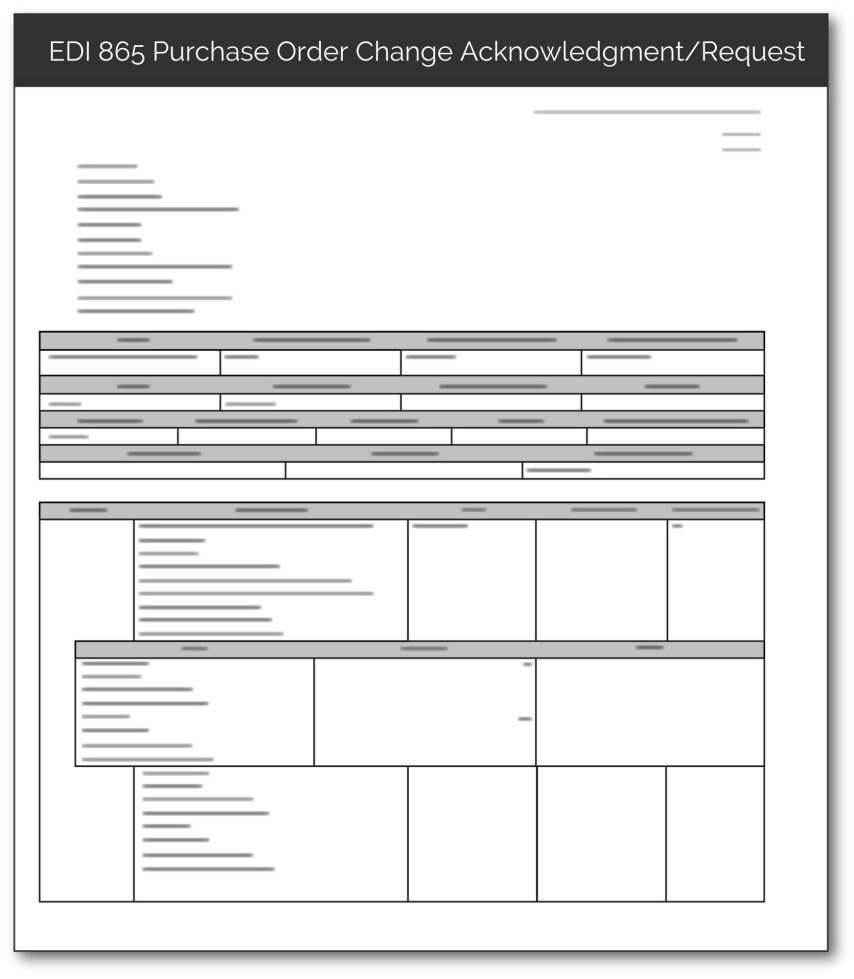EDI 865
Purchase Order Change Acknowledgement/Request - Seller Initiated

What is an EDI 865?
EDI 865, also known as a Purchase Order Change Acknowledgement/Request, is a seller-initiated electronic data interchange transaction set used to communicate with trading partners about an existing purchase order. This document is usually sent in response to an EDI 860 Purchase Order Change Request from a buyer, such as a retailer.
EDI 865 documents follow the x12 format set by the American National Standards Institute (ANSI), a not-for-profit organization that regulates EDI formats in the U.S.
What are the Essential Components of EDI 865?
Because EDI 865 is used to confirm or reject changes to an original order, it will typically have a lot of the same information as the EDI 860. For example, EDI 865 will likely include product descriptions and quantities, buyer and seller information, and shipping and delivery information. The most important aspect of the EDI 865 is that it highlights the confirmation of changes being made to the original order. Changes indicated on EDI 865 may include:
- Quantity or product type changes
- Addition of new items
- Deletion of items
- Price Changes
The seller can also indicate whether a proposed change was rejected, accepted, or accepted with additional adjustments. For example, a supplier might accept additional items, but change the quantity of those based on product availability.

How Do I Use EDI 865?
After placing an order, a buyer might realize they need to make a change. So, the buyer sends EDI 860, a Purchase Order Change Request. The request details the specific changes to the order and requires a response from the seller to confirm.
Upon receiving EDI 860, a seller can use EDI 865 to issue their response. The document will tell the buyer if the change was accepted or rejected, or if a different change is proposed. When the buyer receives EDI 865, they respond with an EDI 997 Functional Acknowledgement.
Alternatively, if a seller gets an order and needs to change an order for any number of reasons, they can also use the EDI 865 to request changes. The main difference between EDI 860 and EDI 865 is the direction they move in: EDI 860 usually goes from the buyer to the seller, and EDI 865 is sent by the seller to the buyer.
Depending on a partner’s EDI requirements, EDI 855 Purchase Order Acknowledgement transactions can also be used to confirm or reject a buyer-initiated purchase order change.
What are the Benefits of EDI 865?
Because EDI 865 is an automated form of exchanging electronic data, it allows buyers and sellers to quickly exchange information and come to agreements, without back-and-forth emailing or long telephone conversations. Generally, EDI documents are protected by encryption, security protocols like HTTPS, and software user authentication, making them a more secure option for partner communications. The best EDI systems are SOC-2 Compliant for added security.
Using EDI 865 also eliminates time-consuming manual data entry, while preventing errors from retyping information across different systems and documents. This ensures data accuracy while giving your team more time to focus on other business needs. Tracking purchase order changes with EDI 865 can also help avoid reconciliation issues, such as invoice discrepancies.


